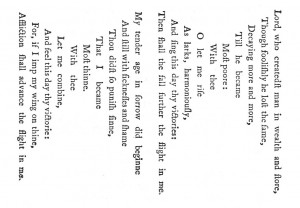One thing I started to think about at the printing workshop this week is how text can sometimes take on the characteristics and implications of visual images. Although we were printing text and forming words as part of our print, the questions we asked ourselves regarding where we would place the words on the page, what style of letters we wanted to use, how we should space the words, where we should place the words in relation to each other, etc. reminded me more of creating a visual image than simply printing or writing text. In concrete or visual poetry, the visual effect of words is more important in conveying meaning than the verbal significance of the text. So in certain works of creative writing, the visual appearance of words does become an image with significance and purpose. Although all the works we’ve looked at in the class thus far have incorporated visual images with text, it’s interesting to consider how text alone can become an image. The process itself of printmaking also felt like an art process, rather than an act of writing, and I think it still would have felt like an art process even if we had chosen to solely print words and not include any images of birds, faces, etc. in the print. The act of finding individual letters, lining them up, creating space in the right places and running the paper through the press gave me the sense that we were creating something. Maybe this is simply because writing in today’s culture has come to mean typing on a laptop keyboard or scribbling notes in a composition book, so I wonder how the conception of this process was different in the time it was commonly used.


Thinking that text is an art is incomprehensible for our generation particularly because we are too used to the speedy typing and production of textual works. There are, however, rare places that produce artistic texts like the place I visited on my orientation trip, Letterpress Printing and Book Arts in Central NY, last August. Prof. Rippeon escorted me and my group to a beautiful place in Skaneateles, a spot where time has not entirely progressed to 2015-then. During the workshop, when we were eagerly searching for the missing parts to complete our typesetting, Prof. Rippeon mentioned that the Bixlers are quite lucky to have all the sorts they on a regular basis. My orientation group visited the Michael and Winifred Bixler’s antique-like workshop, where letters are still treated like artistic components of a textual artwork. This si their website: http://www.mwbixler.com/.
In the fifteenth-century, writing text was also treated as an artistic endeavor by one particular monk that is Poggio Barcciolini whose beautiful handwriting revolutionized copying Latin texts. At that time, copying texts was a detestable practice by some monks because of the tremendous pressure imposed on the monks by the church to work arduously and the handwriting was not legible nor was the writing style fitting to the eloquent potential of Latin. But Poggio had a natural knack for writing elegantly and he also discovered many brilliant texts from classical antiquity by philosophers and literary figures, all discoveries part of what we call “the Renaissance.” Copying brilliant texts in a beautiful handwriting seems fitting to the works’ elevated thought. It seems that our generation has something in common with the dissatisfied monks of the fifteenth-century: lack of awareness of the incredible potential of text as a form of art.